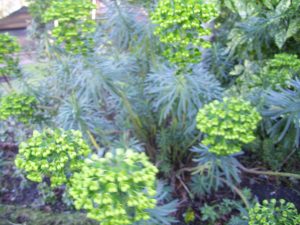We have reached March and spring flowers are at their stunning best to cheer us through, perhaps, the busiest part of the gardening year.

Euphorbias provide brilliant colour and texture from February throughout Spring but watch out for the sap, it can cause irritation!
Jobs to do
• All beds need a mulch both to retain moisture and to suppress those annoying annual weeds that need light to germinate.
• Remove the top 1 to 2 inches (2.5 to 5 cm) of old compost from permanent pot plants and top-dress with fresh. The old compost could be used as mulch.
In the ornamental garden
• Cut back Cornus, grown for their coloured stems, to 2-3 inches (5 to 7.5 cm) from the base because new growth has the best colour next winter.
• Prune bush and standard roses and feed
• Prune last season’s growth of Hydrangea panniculata to the lowest pair of strong buds – they flower on this year’s growth; but prune mop-head hydrangeas by removing dead heads back to the next pair of strong buds – they flower on last year’s growth; cut out a third of old growth at the base to encourage more stems to grow for next year’s flowers.
• Divide Hemerocallis, Astrantia, Hosta, Heuchera and Bergenia as new growth begins.
• Start mowing lawns, but keep the blades high to start with.
In the kitchen garden
• Blueberries: remove one third of the oldest stems to ground level to promote new fruiting wood. Top dress with ericaceous compost
• Gooseberries, red and white currants: remove dead wood, then spur prune all side shoots to 1-3 buds from their base and shorten branch tips by a quarter.
• Start planting early potatoes mid-March and onion and shallot sets.
• Direct sow broad beans, carrots, lettuce, parsnips and peas.
• Prepare trenches for runner beans with well-rotted manure and shredded paper at the base – they do not like to dry out!
• Start off other vegetables under glass.
Above all, keep hoeing off those annual weeds before they set seed!
An opinion on ivy
Most of my gardening neighbours harbour a deep antipathy to ivy, but if you can spare a support and observe the plants, in Spring they provide wonderful nest sites for birds, in Autumn they have flowers popular with bees and other nectar gatherers, and in Winter, their berries feed many wild birds.
Ivies are not parasitic, so do not harm trees they climb on, although the weight of a large ivy may make it top-heavy; nor does it harm walls unless the mortar is already crumbly.
The range of different variegations available, added to their value as a wildlife resource and as a screen to soften walls and fences, makes ivy worth considering as a friend.
Gardens to visit in March open in aid of National Garden Scheme www.ngs.org.uk
25th March: Vann, Hambledon. GU8 4EF
28th March: Beechenwood Farm, Hillside, Odiham. RG29 1JA
